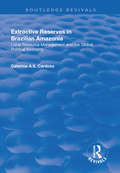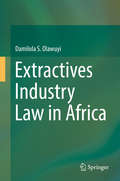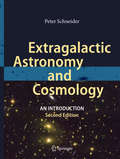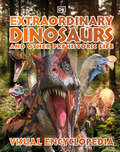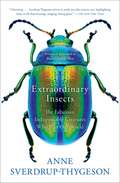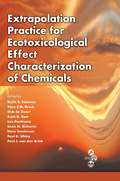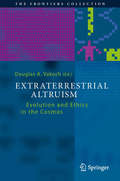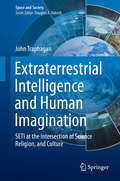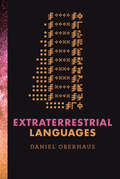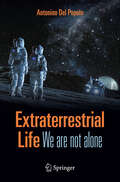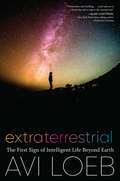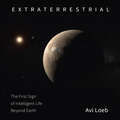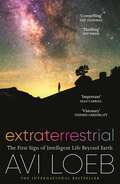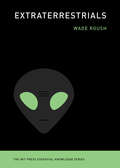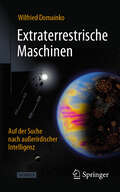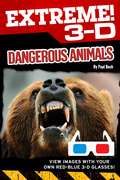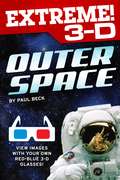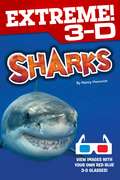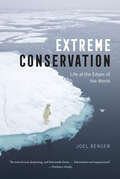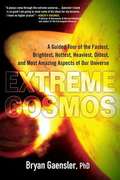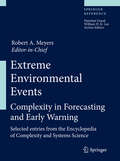- Table View
- List View
Extractive Reserves in Brazilian Amazonia: Local Resource Management and the Global Political Economy (Routledge Revivals)
by Catarina A.S. CardosoThis title was first published in 2003: Despite their growing political significance, the linkages between local resource management and the global political economy are often poorly understood. This book addresses these linkages in a grounded analysis of extractive reserves : areas in Brazil set aside for local populations who depend on natural resources for their livelihood. Extractive reserves are the result of the struggle of the rubber tappers for control over their natural resources and worldwide concern with the conservation of the Amazon Rainforest. The author examines their significance for Brazil as a pioneering legislative and policy initiative to combine conservation with productive use of natural resources, to recognize common property rights to natural resources, and to support traditional populations’ modes of production. Extractive Reserves in Brazilian Amazonia examines the formation and institutional sustainability of the reserves, and in so doing provides a valuable insight into the relationship between local institutions and the wider socio-political and economic context with regard to forest management.
Extractives Industry Law in Africa
by Damilola S. OlawuyiThe book provides a systematic examination of the legal, fiscal and institutional frameworks for the commercial development of petroleum and solid mineral resources in Africa. First, it considers the values, assumptions, and guiding principles underpinning legislation and governance in Africa’s extractive sector. It then provides detailed and comparative evaluations of regulatory frameworks, pricing, local content, procurement, sales, and contractual arrangements across African extractive industries. Further, the book assesses how questions of business and human rights risks, accountability, corporate social responsibility, waste and pollution control, environmental justice, and participatory development have been addressed to date, and how they could be addressed better in the future. Enhancing readers’ understanding of the geography, sources and scope of extractive resources in Africa, the book explains how corporations can effectively identify, mitigate and prevent legal and business risks when investing in African extractive industries. Lastly, it discusses the innovative legal strategies and tools needed to achieve a sustainable and rights-based extractive industry.Written in a user-friendly style, the book offers a valuable resource for corporations, investors, environmental and human rights administrators, advocates, policymakers, judges, international negotiators, government officials and consultants who advise on, or are interested in, petroleum and solid mineral investments in Africa. It also offers students and researchers an authoritative guidebook to the current state of extractive industry laws and institutions in Africa. Numerous examples of how international legal norms could be used to help revitalize the underlying legal and fiscal regimes in African extractive industries – to make them more robust, accountable, sustainable and rights-based – round out the coverage
Extragalactic Astronomy and Cosmology
by Peter SchneiderAccounting for the astonishing developments in the field of Extragalactic Astronomy and Cosmology, this second edition has been updated and substantially expanded. Starting with the description of our home galaxy, the Milky Way, this cogently written textbook introduces the reader to the astronomy of galaxies, their structure, active galactic nuclei, evolution and large scale distribution in the Universe. After an extensive and thorough introduction to modern observational and theoretical cosmology, the focus turns to the formation of structures and astronomical objects in the early Universe. The basics of classical astronomy and stellar astrophysics needed for extragalactic astronomy are provided in the appendix. The new edition incorporates some of the most spectacular results from new observatories like the Galaxy Evolution Explorer, Herschel, ALMA, WMAP and Planck, as well as new instruments and multi-wavelength campaigns which have expanded our understanding of the Universe and the objects populating it. This includes new views on the galaxy population in the nearby Universe, on elliptical galaxies, as well as a deeper view of the distant Universe approaching the dark ages, and an unprecedented view of the distant dusty Universe. Schneider also discusses the impressive support for the standard model of the Universe, which has been substantially strengthened by recent results, including baryon acoustic oscillations (an approach which has significantly matured over the years), results from the completed WMAP mission and from the first Planck results, which have confirmed and greatly improved on these findings, not least by measuring the gravitational lensing effect on the microwave background. Further, a new chapter focusing on galaxy evolution illustrates how well the observations of distant galaxies and their central supermassive black holes can be understood in a general framework of theoretical ideas, models, and numerical simulations. Peter Schneider's Extragalactic Astronomy and Cosmology offers fundamental information on this fascinating subfield of astronomy, while leading readers to the forefront of astronomical research. But it seeks to accomplish this not only with extensive textual information and insights; the author's own passion for exploring the workings of the Universe, which can be seen in the text and the many supporting color illustrations, will further inspire the reader. While this book has grown out of introductory university courses on astronomy and astrophysics and includes a set of problems and solutions, it will not only benefit undergraduate students and lecturers; thanks to the comprehensive coverage of the field, even graduate students and researchers specializing in related fields will appreciate it as a valuable reference work. From the reviews of the first edition: ". . . Masterful blending of observation and theory; lucid exposition. . . (D. E. Hogg, CHOICE, Vol. 44 (10), June, 2007)" "Through the richness of the color illustrations and through the deep insight of the content, the book will most certainly lead the reader to the forefront of astronomical research in this very interesting and fascinating domain of astronomy. . . . will not only be highly appreciated by undergraduate students in astronomy but also by graduate students and researchers involved in the field who will certainly appreciate its comprehensive coverage. (Emile Biémont, Physicalia Magazine, Vol. 29 (4), 2007)"
Extraordinary Dinosaurs and Other Prehistoric Life Visual Encyclopedia
by DKDiscover more than 100 dinosaurs and other prehistoric animals in this exciting children&’s dinosaur encyclopedia! Extraordinary Dinosaurs Visual Encyclopedia is the perfect book for young readers who want to get up close and personal with their favourite prehistoric creatures! Children will be excited to see the fastest, largest, and fiercest creatures, browse their habitats, learn about their claws and spikes, and find out how their fossils help scientists piece together hidden clues about their lives.This must-have dinosaur book for children aged 7–11 features fascinating information on all the major types of dinosaur as well as ancient fish, other prehistoric reptiles in the air or water, and early mammals. Kids will be drawn in and mesmerized by hundreds of exciting images and surprising information on many different dinosaur profiles.Inside the pages of this thrilling dinosaur book for kids, you&’ll find:- More than 100 profiles on dinosaurs and other prehistoric creatures- Fact-filled &‘top trump&’ style profiles on remarkable dinosaurs and other prehistoric creatures- Chapters that span time before the dinosaurs, the age of the dinosaurs, and life after many dinosaurs died out- Clear, engaging text packed with latest facts alongside stunning CGI visuals and artworksThis is the ultimate fact-filled dinosaur reference book for kids who love to have all the latest, weirdest, most in-depth info on the creatures of the prehistoric world at their fingertips. Dinosaur reconstructions and the latest fossil finds bring back to life the bone-crunching teeth of the Tyrannosaurus rex, the astonishingly large body of the Argentinosaurus, and the plane-sized wings of the soaring Hatzegopteryx. Each page reveals new facts from the latest paleontological research, including each animal&’s size, group, habitat, time period, diet, and fossil discovery.
Extraordinary Insects: The Fabulous, Indispensable Creatures Who Run Our World
by Anne Sverdrup-ThygesonThis enthusiastic, witty, and informative introduction to the world of insects and why we could not survive without them is &“a joy&” (The Times, London) and &“charming...Highlighting them in all their buzzing, stinging, biting glory&” (The New York Times Book Review). Insects comprise roughly half of the animal kingdom. They live everywhere—deep inside caves, 18,000 feet high in the Himalayas, inside computers, in Yellowstone&’s hot springs, and in the ears and nostrils of much larger creatures. There are insects that have ears on their knees, eyes on their penises, and tongues under their feet. Most of us think life would be better without bugs. In fact, life would be impossible without them. Most of us know that we would not have honey without honeybees, but without the pinhead-sized chocolate midge, cocoa flowers would not pollinate. No cocoa, no chocolate. The ink that was used to write the Declaration of Independence was derived from galls on oak trees, which are induced by a small wasp. The fruit fly was essential to medical and biological research experiments that resulted in six Nobel prizes. Blowfly larva can clean difficult wounds; flour beetle larva can digest plastic; several species of insects have been essential to the development of antibiotics. Insects turn dead plants and animals into soil. They pollinate flowers, including crops that we depend on. They provide food for other animals, such as birds and bats. They control organisms that are harmful to humans. Life as we know it depends on these small creatures. &“Delivering a hail of facts with brio and precision&” (Nature) Anne Sverdrup-Thygeson shows us that there is more variety among insects than we thought possible and the more you learn about insects, the more fascinating they become. Extraordinary Insects is &“a very enthusiastic look at the flying, crawling, stinging bug universe world, and why we should cherish it&” (The Philadelphia Inquirer). **Note: This book was previously published under the title Buzz, Sting, Bite.
Extrapolation Practice for Ecotoxicological Effect Characterization of Chemicals
by Keith R. Solomon Paul J. Van Den Brink Theo C. M. Brock Dick De Zwart Scott D. Dyer Leo Posthuma Sean Richards Hans Sanderson Paul SibleyA wide-ranging compilation of techniques, Extrapolation Practice for Ecotoxicological Effect Characterization of Chemicals describes methods of extrapolation in the framework of ecological risk assessment. The book, informally known as EXPECT, identifies data needs and situations where these extrapolations can be most usefully applied, makin
Extraterrestrial Altruism
by Douglas A. VakochExtraterrestrial Altruism examines a basic assumption of the Search for Extraterrestrial Intelligence (SETI): that extraterrestrials will be transmitting messages to us for our benefit. This question of whether extraterrestrials will be altruistic has become increasingly important in recent years as SETI scientists have begun contemplating transmissions from Earth to make contact. Technological civilizations that transmit signals for the benefit of others, but with no immediate gain for themselves, certainly seem to be altruistic. But does this make biological sense? Should we expect altruism to evolve throughout the cosmos, or is this only wishful thinking? Is it dangerous to send messages to other worlds, as Stephen Hawking has suggested, or might humankind benefit from an exchange with intelligence elsewhere in the galaxy? Would extraterrestrial societies be based on different ethical principles, or would we see commonalities with Earthly notions of morality? Extraterrestrial Altruism explores these and related questions about the motivations of civilizations beyond Earth, providing new insights that are critical for SETI. Chapters are authored by leading scholars from diverse disciplines--anthropology, astronomy, biology, chemistry, computer science, cosmology, engineering, history of science, law, philosophy, psychology, public policy, and sociology. The book is carefully edited by Douglas Vakoch, Director of Interstellar Message Composition at the SETI Institute and professor of clinical psychology at the California Institute of Integral Studies. The Foreword is by Frank Drake. This interdisciplinary book will benefit everybody trying to understand whether evolution and ethics are unique to Earth, or whether they are built into the fabric of the universe.
Extraterrestrial Civilizations
by Isaac AsimovThe master of science fiction speculates about life on other planets..."Intriguing"--Publishers Weekly From the Trade Paperback edition.
Extraterrestrial Intelligence and Human Imagination
by John TraphaganThe search for extraterrestrial intelligence (SETI) represents one of the most significant crossroads at which the assumptions and methods of scientific inquiry come into direct contact with--and in many cases conflict with--those of religion. Indeed, at the core of SETI is the same question that motivates many interested in religion: What is the place of humanity in the universe? Both scientists involved with SETI (and in other areas) and those interested in and dedicated to some religious traditions are engaged in contemplating these types of questions, even if their respective approaches and answers differ significantly. This book explores this intersection with a focus on three core points: 1) the relationship between science and religion as it is expressed within the framework of SETI research, 2) the underlying assumptions, many of which are tacitly based upon cultural values common in American society, that have shaped the ways in which SETI researchers have conceptualized the nature of their endeavor and represented ideas about the potential influence contact might have on human civilization, and 3) what sort of empirical evidence we might be able to access as a way of thinking about the social impact that contact with alien intelligence might have for humanity, from both religious and cultural perspectives. The book developed as a result of a course the author teaches at the University of Texas at Austin: Religion, Science, and the Search for Extraterrestrial Intelligence.
Extraterrestrial Languages (The\mit Press Ser.)
by Daniel OberhausIf we send a message into space, will extraterrestrial beings receive it? Will they understand?The endlessly fascinating question of whether we are alone in the universe has always been accompanied by another, more complicated one: if there is extraterrestrial life, how would we communicate with it? In this book, Daniel Oberhaus leads readers on a quest for extraterrestrial communication. Exploring Earthlings' various attempts to reach out to non-Earthlings over the centuries, he poses some not entirely answerable questions: If we send a message into space, will extraterrestrial beings receive it? Will they understand? What languages will they (and we) speak? Is there not only a universal grammar (as Noam Chomsky has posited), but also a grammar of the universe? Oberhaus describes, among other things, a late-nineteenth-century idea to communicate with Martians via Morse code and mirrors; the emergence in the twentieth century of SETI (the search for extraterrestrial intelligence), CETI (communication with extraterrestrial intelligence), and finally METI (messaging extraterrestrial intelligence); the one-way space voyage of Ella, an artificial intelligence agent that can play cards, tell fortunes, and recite poetry; and the launching of a theremin concert for aliens. He considers media used in attempts at extraterrestrial communication, from microwave systems to plaques on spacecrafts to formal logic, and discusses attempts to formulate a language for our message, including the Astraglossa and two generations of Lincos (lingua cosmica).The chosen medium for interstellar communication reveals much about the technological sophistication of the civilization that sends it, Oberhaus observes, but even more interesting is the information embedded in the message itself. In Extraterrestrial Languages, he considers how philosophy, linguistics, mathematics, science, and art have informed the design or limited the effectiveness of our interstellar messaging.
Extraterrestrial Life: We are not alone
by Antonino Del PopoloAre we alone in the universe? This ancient question remains unanswered, but we are inching closer to finding out. Since the 1970s, probes have explored various objects in our solar system, revealing no advanced civilizations beyond Earth. However, bacterial life likely existed on Mars and might still exist today. Venus, though a scorching hellscape, could host bacterial life in its atmosphere. Some moons of gas giants are believed to harbor underground oceans potentially capable of supporting life. The greatest hopes for discovering life lie in the myriad of exoplanets in our galaxy and beyond, the first of which was discovered in 1995. This discovery revolutionized our understanding, showing that planets are common, with each star often hosting one or more. This significantly increases the likelihood of both microscopic life and advanced civilizations. While not all planets are suitable for life, billions of habitable planets exist in our galaxy alone, some even classified as super-habitable, possessing conditions more favorable for life than Earth. Current and future space telescopes aim to study these planets' atmospheres, searching for life-producing molecules. One such molecule, produced exclusively by life, has already been detected on a discovered planet. Despite extensive searches, no signals from other civilizations have been found, but this doesn't rule out their existence. Recent studies based on star formation, the prevalence of planets, and the potential for life-supporting conditions suggest that technological civilizations have certainly existed in the Universe. The next decade will be crucial in answering the question: are we alone?
Extraterrestrial Seismology
by Vincent C. H. Tong Rafael A. GarcíaSeismology is a highly effective tool for investigating the internal structure of the Earth. Similar techniques have also successfully been used to study other planetary bodies (planetary seismology), the Sun (helioseismology), and other stars (asteroseismology). Despite obvious differences between stars and planetary bodies, these disciplines share many similarities and together form a coherent field of scientific research. This unique book takes a transdisciplinary approach to seismology and seismic imaging, reviewing the most recent developments in these extraterrestrial contexts. With contributions from leading scientists, this timely volume systematically outlines the techniques used in observation, data processing, and modelling for asteroseismology, helioseismology, and planetary seismology, drawing comparisons with seismic methods used in geophysics. Important recent discoveries in each discipline are presented. With an emphasis on transcending the traditional boundaries of astronomy, solar, planetary and Earth sciences, this novel book is an invaluable resource and reference for undergraduates, postgraduates and academics.
Extraterrestrial: The First Sign of Intelligent Life Beyond Earth
by Avi LoebHarvard’s top astronomer lays out his controversial theory that our solar system was recently visited by advanced alien technology from a distant star. In late 2017, scientists at a Hawaiian observatory glimpsed an object soaring through our inner solar system, moving so quickly that it could only have come from another star. Avi Loeb, Harvard’s top astronomer, showed it was not an asteroid; it was moving too fast along a strange orbit, and left no trail of gas or debris in its wake. There was only one conceivable explanation: the object was a piece of advanced technology created by a distant alien civilization. In Extraterrestrial, Loeb takes readers inside the thrilling story of the first interstellar visitor to be spotted in our solar system. He outlines his controversial theory and its profound implications: for science, for religion, and for the future of our species and our planet. A mind-bending journey through the furthest reaches of science, space-time, and the human imagination, Extraterrestrial challenges readers to aim for the stars—and to think critically about what’s out there, no matter how strange it seems. <P><P> <b>A New York Times Bestseller</b>
Extraterrestrial: The First Sign of Intelligent Life Beyond Earth
by Avi LoebThe world's most eminent scientist of space explains why he believes in extraterrestrial life'VISIONARY' Stephen GreenblattHarvard's top astronomer lays out his controversial theory that our solar system was recently visited by advanced alien technology. In late 2017, scientists at a Hawaiian observatory glimpsed a strange object soaring through our inner solar system. Astrophysicist Avi Loeb conclusively showed it was not an asteroid; it was moving too fast along a strange orbit, and leaving no trail of gas or debris in its wake. There was only one conceivable explanation: the object was a piece of advanced technology created by a distant alien civilization. In Extraterrestrial, Loeb takes readers inside the thrilling story of the first interstellar visitor to be spotted in our solar system. He outlines his theory and its profound implications: for science, for religion, and for the future of our planet. A mind-bending journey through the furthest reaches of science, space-time, and the human imagination, Extraterrestrial challenges readers to aim for the stars-and to think critically about what's out there, no matter how strange it seems.(P) 2021 Houghton Mifflin Harcourt
Extraterrestrial: The First Sign of Intelligent Life Beyond Earth
by Avi Loeb'VISIONARY' Stephen Greenblatt'So interesting... I recommend [Extraterrestrial] to people who have any interest in this extraordinary subject of life existing in other places than on Earth.' William Shatner (from Amazon.com)Harvard's top astronomer takes us inside the mind-blowing story of the first interstellar visitor to our solar system In late 2017, scientists at a Hawaiian observatory glimpsed a strange object soaring through our inner solar system. Astrophysicist Avi Loeb conclusively showed it was not an asteroid; it was moving too fast along a strange orbit, and leaving no trail of gas or debris in its wake. There was only one conceivable explanation: the object was a piece of advanced technology created by a distant alien civilization. In Extraterrestrial, Loeb takes readers inside the thrilling story of the first interstellar visitor to be spotted in our solar system. He outlines his theory and its profound implications: for science, for religion, and for the future of our planet. A mind-bending journey through the furthest reaches of science, space-time, and the human imagination, Extraterrestrial challenges readers to aim for the stars-and to think critically about what's out there, no matter how strange it seems.
Extraterrestrials (The MIT Press Essential Knowledge Series)
by Wade RoushAre we alone in the universe? If not, where is everybody? An engaging exploration of one of the most important unsolved problems in science. Everything we know about how planets form and how life arises suggests that human civilization on Earth should not be unique. We ought to see abundant evidence of extraterrestrial activity—but we don't. Where is everybody? In this volume in the MIT Press Essential Knowledge series, science and technology writer Wade Roush examines one of the great unsolved problems in science: is there life, intelligent or otherwise, on other planets? This paradox (they're bound to be out there; but where are they?), first formulated by the famed physicist Enrico Fermi, has fueled decades of debate, speculation, and, lately, some actual science. Roush lays out the problem in its historical and modern-day context and summarizes the latest thinking among astronomers and astrobiologists. He describes the long history of speculation about aliens (we've been debating the idea for thousands of years); the emergence of SETI (the Search for Extraterrestrial Intelligence) as a scientific discipline in the 1960s, and scientists' use of radio and optical techniques to scan for signals; and developments in astrobiology (the study of how life might arise in non-Earth like environments) and exoplanet research (the discovery of planets outside our solar system). Finally, he discusses possible solutions to the Fermi Paradox and suggests way to refocus SETI work that might increase the chances of resolving the paradox—and finding extraterrestrials.
Extraterrestrische Maschinen: Auf der Suche nach außerirdischer Intelligenz
by Wilfried DomainkoIn diesem Buch wird die Suche nach extraterrestrischen Strukturen diskutiert, die möglicherweise künstlichen Ursprungs sind. Die Fahndung nach künstlichen, extraterrestrischen Objekten wird jedoch durch die extrem vielfältigen Erscheinungsformen von natürlichen Himmelkörpern erschwert. Trotzdem ist die gezielte Suche nach außerirdischen Maschinen von riesigen Ausmaßen eine Möglichkeit, extraterrestrische Intelligenz zu entdecken. Tatsächlich besteht die Möglichkeit, einige Beobachtungen von außergewöhnlichen Himmelsobjekten entweder im Zusammenhang mit exotischen natürlichen Phänomenen oder aber als solche Technologiesignaturen zu deuten. Extraterrestrische Maschinen könnten technologisch viel fortschrittlicher sein als ihre irdischen Gegenstücke. Im Rahmen des zweiten Erklärungsansatzes könnten modifizierte Sterne als stellare Maschinen dienen, ganze Planeten nach den Bedürfnissen ihrer Bewohner umgestaltet werden oder gigantische Megastrukturen ihre Heimatsterne verdunkeln. Auch in unserem Sonnensystem wären Signaturen von extraterrestrischen Maschinen denkbar. Entsprechend könnten Beobachtungen von einigen sich bewegenden Himmelsobjekten mitunter im Zusammenhang mit interstellaren Raumsonden oder extraterrestrischem Weltraumschrott interpretiert werden. Neben der Vorstellung von möglichen beobachteten Technologiesignaturen und deren natürlichen und künstlichen Erklärungsmodellen, werden in diesem Buch auch verwandte irdische Technikvorhaben mit den entsprechenden Beobachtungen verglichen. In diesem Zusammenhang könnte das Auffinden von extraterrestrischen Maschinen sogar die menschliche Technologieentwicklung verändern.
Extreme 3-D: Dangerous Animals
by Paul BeckWarning: Extreme danger! They stalk, sting, pounce, and chomp. They're the deadliest creatures on earth, and now you can see why as you explore them all through incredible 3-D photos. Extreme 3-D: Dangerous Animals brings you face-to-face with tigers, wolves, great whites, and cobras--and a few animals you might not expect!
Extreme 3-D: Outer Space
by Paul BeckExplore outer space from our solar system to the edges to the universe! Extreme 3-D: Outer Space pairs the most bizarre and mind-blowing facts about our planets with breathtaking images--all in 3-D!
Extreme 3-D: Sharks
by Nancy HonovichGo face-to-face with the world's most awesome predators! Extreme 3-D: Sharks is packed with incredible 3-D photos of the most fasincating creatures in the sea!
Extreme Animals: The Toughest Creatures on Earth (Animal Science)
by Nicola DaviesFrom the persevering emperor penguins of the South Pole to the brave bacteria inside bubbling volcanoes, from the hardy reptiles of the driest deserts to the squash-proof creatures of the deepest seabeds, animals have adapted to survive in conditions that would kill a human faster than you can say "coffin." Discover how they do it in this amazing natural history book from a celebrated team -- and find out who wins the title of the toughest animal of them all. Back matter includes an index and a glossary.
Extreme Biomimetics
by Hermann EhrlichThis book discusses the current direction of the research approach to extreme biomimetics through biological materials-inspired chemistry and its applications in modern technology and medicine. It is a resource covering topics of extreme (psychrophilic and thermopilic) biomineralization, solvothermal and hydrothermal chemistry of metal oxides and nanostructured composites, and bioinspired materials science in a diverse areas. The authors review the current advances in the extreme biomimetics research field and describe various approaches introduced and explored by their respective laboratories. * Details the basic principles of extreme biomimetics approach for design of new materials and applications; * Includes numerous examples of the hierarchical organization of hydrothermally or psychrophilically obtained biocomposites, structural bioscaffolds, biosculpturing, biomimetism, and bioinspiration as tools for the design of innovative materials; * Describes and details the principles of extreme biomimetics with respect to metallization of chemically and thermally stable biopolymers.
Extreme Conservation: Life at the Edges of the World
by Joel Berger"Extraordinary. . . . Berger is a hero of biology who deserves the highest honors that science can bestow."—Tim Flannery, New York Review of Books On the Tibetan Plateau, there are wild yaks with blood cells thinner than those of horses’ by half, enabling the endangered yaks to survive at 40 below zero and in the lowest oxygen levels of the mountaintops. But climate change is causing the snow patterns here to shift, and with the snows, the entire ecosystem. Food and water are vaporizing in this warming environment, and these beasts of ice and thin air are extraordinarily ill-equipped for the change. A journey into some of the most forbidding landscapes on earth, Joel Berger’s Extreme Conservation is an eye-opening, steely look at what it takes for animals like these to live at the edges of existence. But more than this, it is a revealing exploration of how climate change and people are affecting even the most far-flung niches of our planet. Berger’s quest to understand these creatures’ struggles takes him to some of the most remote corners and peaks of the globe: across Arctic tundra and the frozen Chukchi Sea to study muskoxen, into the Bhutanese Himalayas to follow the rarely sighted takin, and through the Gobi Desert to track the proboscis-swinging saiga. Known as much for his rigorous, scientific methods of developing solutions to conservation challenges as for his penchant for donning moose and polar bear costumes to understand the mindsets of his subjects more closely, Berger is a guide par excellence. He is a scientist and storyteller who has made his life working with desert nomads, in zones that typically require Sherpas and oxygen canisters. Recounting animals as charismatic as their landscapes are extreme, Berger’s unforgettable tale carries us with humor and expertise to the ends of the earth and back. But as his adventures show, the more adapted a species has become to its particular ecological niche, the more devastating climate change can be. Life at the extremes is more challenging than ever, and the need for action, for solutions, has never been greater.
Extreme Cosmos: A Guided Tour of the Fastest, Brightest, Hottest, Heaviest, Oldest, and Most Amazing Aspects of Our Universe
by Bryan GaenslerA star-gazer since childhood, astronomer Gaensler has not lost his wide-eyed fascination with the stars. In this engaging, accessible, and eye-opening read, he gives readers a guided tour of the universe, with an emphasis on the extremes of temperature, light, and more.
Extreme Environmental Events: Complexity in Forecasting and Early Warning
by Robert A. MeyersExtreme Environmental Events is an authoritative single source for understanding and applying the basic tenets of complexity and systems theory, as well as the tools and measures for analyzing complex systems, to the prediction, monitoring, and evaluation of major natural phenomena affecting life on earth. These phenomena are often highly destructive, and include earthquakes, tsunamis, volcanoes, climate change,, and weather. Early warning, damage, and the immediate response of human populations to these phenomena are also covered from the point of view of complexity and nonlinear systems. In 61 authoritative, state-of-the art articles, world experts in each field apply such tools and concepts as fractals, cellular automata, solitons game theory, network theory, and statistical physics to an understanding of these complex geophysical phenomena.
